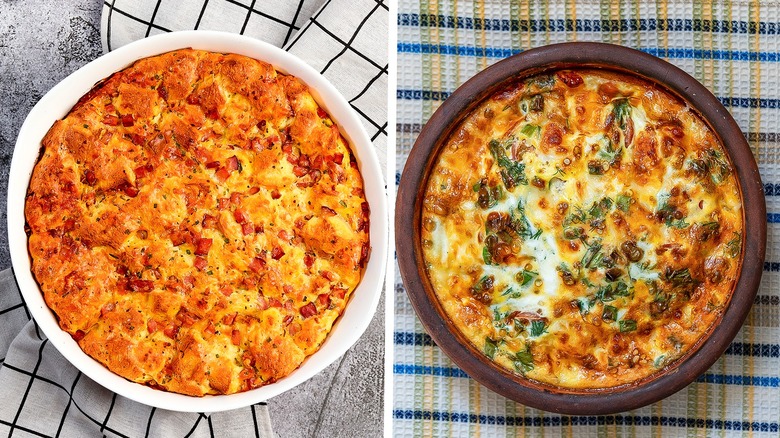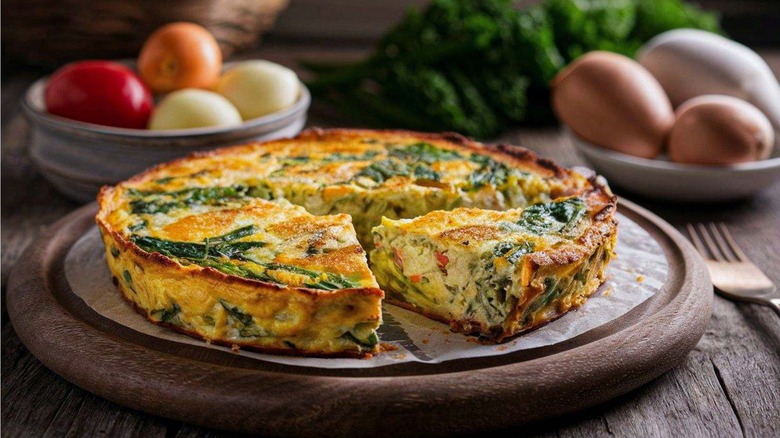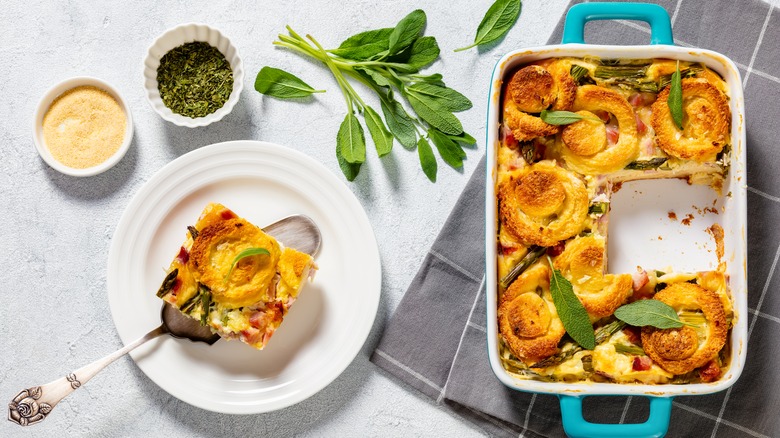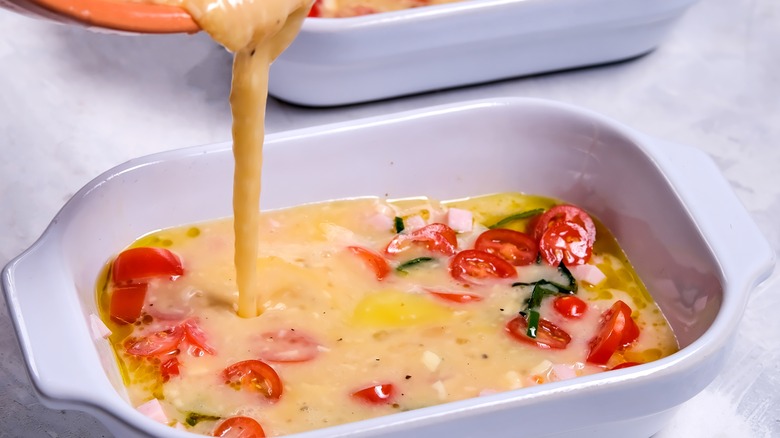The Differences Between Strata And Frittata
There's truth to the American Egg Board's slogan — eggs are not only edible but incredible. It's hard to think of a tasty culinary workhorse more versatile. There are dozens of different egg dishes and preparations for every preference and occasion, from hard-boiled eggs to fuel you up pre-work or pre-gym to luscious, buttery poached eggs over leafy green salads to decadent rich, salty, carby eggs Benedict brunches. Two of our favorite egg-starring dishes are reminiscent of egg cakes or pies, slice-able delights stuffed with assorted fillings and harmoniously fusing fluffy, buttery, creamy, crispy, snappy textures: frittatas and stratas. But for all of their similarities, these egg bakes have their differences, too, and understanding those will help you seamlessly incorporate both into an elevated egg repertoire that will have your brunch guests thrilled.
Both frittatas and stratas use eggs as the main ingredient of a dish served sliced. The eggs act as not only a key flavor and texture driver but also as the binding agent for whatever fixings you want to add in, from meats like sausage or bacon to veggies like peppers or mushrooms to ooey, gooey cheeses. But they diverge when it comes to other core ingredients as well as heating methods. Let's get into the eggy details.
What is a frittata?
The frittata is closely related to the quiche, but while different variations on the classic French quiche are all baked into a pie crust, the Italian frittata is crustless. Both quiche and frittata are formed by combining eggs with dairy for a custardy finish. In fact, to make a frittata, there's a golden ratio of eggs to dairy, which is one egg per ½ cup of milk or cream.
The frittata is also a cousin of the omelet, because you're essentially beating eggs, adding in your fillings, and cooking. For an omelet, you just whisk the eggs to combine them, add your meats, veggies, or cheeses, and fold the egg omelet over, all on the stove. Whereas for a quiche, you'd add your mix-ins into your egg- and dairy-filled pie crust and bake it all in the oven. The frittata charts its own course, taking the fluffy yet creamy dairy-infused texture of the quiche and the simple toss-in of fillings of the omelet, and then combining their cooking methods by first being heated on the stove and then being finished in the oven so that the top sets into a slice-able form.
The magic of the frittata is that you can get creative. There are all kinds of delectable frittata recipes, and you can also just wing it with what's in your kitchen. Spinach, broccoli, prosciutto, potatoes, feta, gouda — there's nothing that won't taste even better when baked into eggs and cream with a browned, crisped exterior.
What is a strata?
As far as what you could compare a strata to, it's kind of like a bread pudding, but still different. Think of a strata like a casserole, which is the type of dish you'll likely prepare it in. The bread and any fillings you're using get layered into the dish, and then a mixture of eggs and dairy is poured on top. The entire dish is then baked in the oven until the eggs are set and the top is golden brown. If that sounds a lot like bread pudding, well, you're right — the key differentiator, really, is that bread pudding tends to be sweet while an egg strata dish would be savory, like a ham and cheese strata, for example. Plus, while bread pudding is English in origin, the strata is actually an American creation. If you're keeping score, that's quiche and omelets for France, frittatas for Italy, bread pudding for England, and stratas for the United States.
Like any of these dishes, you can really mix it up when it comes to fillings. But the strata (like bread pudding) boasts the added appeal of bread, and it's a great way to keep leftover bread from going to waste. Day-old bread is actually better than fresh bread because when it's dry, it'll soak up all that eggy goodness so that every bite is bursting with buttery creaminess.
Strata is distinguished by bread
In addition to quiche, omelets, and bread pudding, you can spot the uniting similarities between frittatas and stratas. Combination of eggs and dairy for custardy consistency? Check. A freedom to add in any combination of meats, vegetables, cheese, herbs, and spices you see fit? Check again. But differences pop up from pie crusts to no pie crusts to heating methods, all subtly shaping these dishes and making them their own special delights, each worthy of a place in your brunch lineup. Importantly, the main standout variation between a frittata and a strata is bread.
Frittatas are really defined by their lack of bread, as they don't have the pie crust of a quiche nor the layered-in bread of a strata. Meanwhile, it's that very bread addition that makes a strata special — it's not dessert like bread pudding, often made with things like nuts, raisins, and baking spices. It's a savory dish spotlighting eggs but with that toothsome twist of tasty bread. When you want something a little lighter, opt for the frittata, and when you want a dish to warm you up on a winter's day, go strata.



